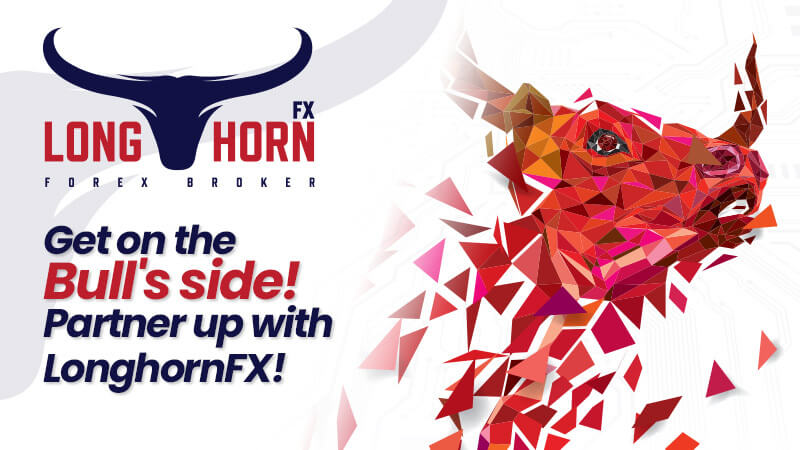A newly born brand such as the Longhorn FX is another crypto-only deposit broker. This trend of crypto-deposit/withdrawal investment platforms is booming since 2017. Longhorn FX is presented as a true ECN STP type broker, but as usual, they are connected to other market makers or liquidity providers. Meaning a direct connection to the interbank market is absent. The brand is founded in July 2020 and is not regulated. The regulation of crypto only brokers does not exist. Still, their agents might say they are looking for regulation, and it might come down to Financial Services Authority – St. Vincent & the Grenadines. Unregulated brokers are not necessarily unethical; many brokers deal with crypto-only funding and withdrawals, maintaining an excellent reputation. What’s more, these brokerages are an easy solution for US-based traders looking for relaxed trading conditions.
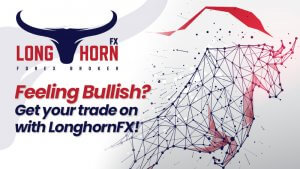 When it comes to presentation, Longhorn FX does not have anything eyecatching compared to the competition of the same kind. Certainly, the conditions presented are very good, much better than what you would expect from a regulated broker. When it comes to leverage, spreads, trading costs, and other trading conditions, most clients will hardly find anything to complain about. Longhorn FX website has only one domain ending with .com, with a good looking website without overly flashy makeup. High leverage is the first feature marketed, followed by trading assets range, although the rest of the features are unimpressive for the established trader, except maybe for the 24/7 support availability. The rest of the website does not give out anything worthy. Most of it is filled with usual marketing phrases without substance. There is a FAQ section that provides straight answers to common questions. You might see the spreads (live but updated on page reload) but no information on commissions, not even in the FAQ. The commission is charged and can be seen on the platform; however, we think this information is very important and should be clear on the website. We will check out each of the promoted features, trader experience and provide you with actual results in this article.
When it comes to presentation, Longhorn FX does not have anything eyecatching compared to the competition of the same kind. Certainly, the conditions presented are very good, much better than what you would expect from a regulated broker. When it comes to leverage, spreads, trading costs, and other trading conditions, most clients will hardly find anything to complain about. Longhorn FX website has only one domain ending with .com, with a good looking website without overly flashy makeup. High leverage is the first feature marketed, followed by trading assets range, although the rest of the features are unimpressive for the established trader, except maybe for the 24/7 support availability. The rest of the website does not give out anything worthy. Most of it is filled with usual marketing phrases without substance. There is a FAQ section that provides straight answers to common questions. You might see the spreads (live but updated on page reload) but no information on commissions, not even in the FAQ. The commission is charged and can be seen on the platform; however, we think this information is very important and should be clear on the website. We will check out each of the promoted features, trader experience and provide you with actual results in this article.
Account Types

Longhorn FX does not have any specific packages or account types you can select. What you get is what everybody gets. Conditions are the same, without any categorization with the minimum deposit. This is actually a good thing. It means you can enjoy full features without prerequisites typically created to push clients for a larger deposit amount. However, Longhorn FX is a very fresh broker, and it is working on the marketing of its products, and things in this area might change. It would be sad to see if account types are made based on “artificially” higher spreads for small deposits or other restrictions on asset ranges. Keeping things simple, though, is what we would seek with a broker, so hopefully, Longhorn FX will not introduce any “packaged” products – account types.
The website account-making process is easy, with the email, username, and password setup. However, you will also be prompted to enter your phone. This step can be skipped, but you would likely need it to set up two-factor authentication available for your account. You will be asked for the SMS code sent to your phone number, or you can have them contact you.
The dashboard is very well organized, with a clear UI. A progress bar is dominant, which leads you to trade after you give your phone, deposit, and open the MT4 account. Of course, the progress bar is created as a passive push to deposit and trade, but the rest of the account management is covering most of what the trader needs. Traders will be able to make multiple live or demo accounts with a nice step by step guide for beginners. Internal transactions between accounts are available, transaction history (not trading history), withdraw and deposit funds, download the trading platform based on the operating system wanted, demo and live accounts overview, and the affiliate program activity. If you apply to the Longhorn FX affiliate program, you will also have a nice affiliate account management and support as Longhorn FX is a new broker and obviously needs new clients. In the settings section, you will not be able to change much. Here you can change your personal information, such as the name or email, enable Two Factor Authentication, unsubscribe from emails, and, interestingly, have the option to unsubscribe from the Longhorn FX agent calling lists. The broker claims they do not have conversion agents, but this setting might prove otherwise.
Platforms
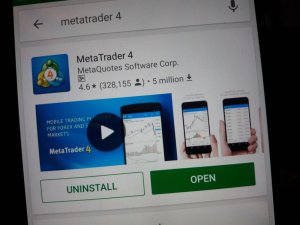
MetaTrader 4 is a very popular platform, although it is not the newest. MetaQuotes ceased issuing new licenses for this platform to push the new MT5. Yet, the customization availability and support in terms of addons and custom indicators, Expert Advisors, are not yet at the same level as with the MT4. Longhorn FX offers only the MT4 platform, meaning it is probably a brand belonging to a network or an affiliate, putting another suspicion they are “true ECN STP” broker as claimed on their website. However, it all comes down to how good are execution times, spreads, liquidity stability, and other trading conditions we like, be it ECN behind a market maker or direct access to the interbank market.
Installing the MT4 is quite easy. Longhorn FX branded the installation wizard with their logos and such and have provided a quick menu link to download the MT4 installer. The MT4 is available for Android, iOS, Windows, and as a web trader without any need for installation. Webtrader is available immediately on the website homepage, so you can see the trading conditions without any registration process except on the MT4 platform. Clicking on the “demo” button on the web trader, you can do that easily too.
Once the MT4 client is installed, you will have two servers available, “Demo2” and “Real2” The ping rate for the demo is 122.56 ms, while the real account is 115.10 ms, which is good enough for an ECN broker without a dealing desk. The MT4 platform is registered to Longhorn LLC with an address in – St. Vincent & the Grenadines, the one many other offshore brokers use. The phone presented is from the UK, but it is an IP phone as usual. The platform is updated to the latest version, and it is on default MT4 settings with a classic arrangement of 4 major currency pairs windows with One-Click trading buttons visible. The charts do not go beyond July 2020 on any asset, meaning you will need to download the data form the MetaQuotes data center. This is done via the History Center (F2). To beginners, this might be unknown, and if you want to backtest on daily, weekly, or monthly timeframes, you will need to download the history for each asset. This process might take some time, though, especially if you are interested in many assets. There are no additional indicators installed and no special templates except for the default ones. We have installed several systems and indicators on the MT4 platform without any problems. The asset specification windows show all the information a normal trade would need, including swaps, stop levels, swap types, etc. The asset (market Watch) panel is nicely categorized, although the Terminal shows the commission column with an amount not shown in the asset specification windows. As for execution times on the EUR/USD pair, which should be the most liquid, are averaging 200 ms, although, on some occasions, it could get to 300 ms or more. This deviation should not be a problem for regular traders and Expert Advisors, but some might want better. The same lag times are for the exotic currency pairs, metals, crypto, and other assets. The broker does not restrict Expert Advisors, hedging, scalping, or other trading techniques. The liquidity provider for their crypto assets is Bitfinex. Providers for other markets are not disclosed, probably to avoid arbitrage trading. Overall, the MT4 platform has an acceptable lag and should suffice most of the traders, even though the broker does not offer any alternatives. In the future, Longhorn FX will probably introduce MetaTrader 5.
Leverage
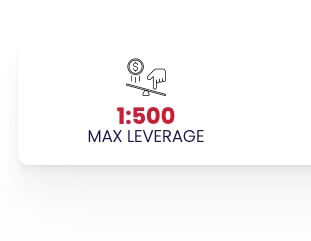 It seems Longhorn FX’s main selling point is the high leverage of 1:500. To some traders, this is important. Most of them are using small accounts and unorthodox money management. The advantage of opening small accounts is probably due to the broker risk, and prefer higher leverage to compensate for small buying power. When creating a Trading Account, you are given the option to choose the leverage of your choice, which is between 1:1 and 1:500. This leverage selection would apply to Forex and Metals. The following instruments are capped to the following: Stocks: – 1:20, Cryptocurrencies – 1:100, Energies – 1:100 and Indices – 1:200. These leverage levels are high when compared to other brokers, especially the ones for cryptocurrencies since they are the most volatile of all asset categories. We have checked the leverage for each of the categories in the MT4, and they are in line with the information in the FAQ section, with a few exceptions. Namely, forex exotic currency pairs like the USD/TRY have 1:100 leverage, although it is limited to the most volatile pairs. Other assets such as BTC/USD hold to the 1:100 leverage, just know Ethereum and other crypto does not have any leverage.
It seems Longhorn FX’s main selling point is the high leverage of 1:500. To some traders, this is important. Most of them are using small accounts and unorthodox money management. The advantage of opening small accounts is probably due to the broker risk, and prefer higher leverage to compensate for small buying power. When creating a Trading Account, you are given the option to choose the leverage of your choice, which is between 1:1 and 1:500. This leverage selection would apply to Forex and Metals. The following instruments are capped to the following: Stocks: – 1:20, Cryptocurrencies – 1:100, Energies – 1:100 and Indices – 1:200. These leverage levels are high when compared to other brokers, especially the ones for cryptocurrencies since they are the most volatile of all asset categories. We have checked the leverage for each of the categories in the MT4, and they are in line with the information in the FAQ section, with a few exceptions. Namely, forex exotic currency pairs like the USD/TRY have 1:100 leverage, although it is limited to the most volatile pairs. Other assets such as BTC/USD hold to the 1:100 leverage, just know Ethereum and other crypto does not have any leverage.
Trade Sizes

Longhorn FX does not experiment or limit your trading with high trading size minimums, so they stick with the standard contract sizes for all asset categories. Contract sizes for forex currency pairs are 100000 units for one lot. For indexes is 100 except for the Nikkei 225 with 1000 units. Stocks are also 100 shares, while energy assets have standard 1000 units per contract. Precious metals are also standard 100 units per contract or one lot except for the XAG/USD with 5000 units. However, cryptos have contract sizes that, according to the specification windows, are not standard. So for Bitcoin against the USD, one contract is ten units or ten coins. Smaller value coins have 100 units per contract, while very small value coins such as IOTA have 1000 units per contract.
As for the minimum trading volume sizes, Longhorn FX is fair. Major currency pairs stick to the standard micro-lot minimum trading sizes or 0.01 lots, and no stop level limits. The maximal volume is 1000 lots. Cross pairs are also in micro-lots, and no stops level, while exotics are no different. All forex pairs have 0.01-lot volume steps (additional position size) and no stops level (minimum range from the current price where pending orders can be set).
Indexes are the same in terms of trading sizing. Minimal volume is in micro-lots, with no stops level, and 0.01-lot minimum trade volume size.
Stocks are a bit different. Stops level is set at 20 points for all companies. Sizing has the same 0.01 lot minimum trade size volume, step, and 1000 lots maximum.
Energy and Metal assets have the same structure as currency pairs, but cryptos have a small modification – they have a stops level of 10 points.
Overall, Longhorn FX does not have restrictions you should worry about when it comes to trade sizes. All EAs that do not rely on extremely fast scalping strategies on cryptocurrencies where one pip matters are good to go.
Trading Costs
 Longhorn FX charges a commission of 6 USD/EUR/GBP or 600 BITs per trade per lot. This information is not disclosed on the website, probably because it is not good for marketing. Unfortunately, even the FAQ section with various trading conditions is missing the commission info. The only place where a commission is mentioned is in the affiliate program section. Of course, this commission is not related to trading costs.
Longhorn FX charges a commission of 6 USD/EUR/GBP or 600 BITs per trade per lot. This information is not disclosed on the website, probably because it is not good for marketing. Unfortunately, even the FAQ section with various trading conditions is missing the commission info. The only place where a commission is mentioned is in the affiliate program section. Of course, this commission is not related to trading costs.
Swap fees and credits are applied, and the values are visible only in the MT4 instrument specification window. Swaps are calculated in points except for the cryptocurrencies for which the swaps are in percentages. Triple swaps are charged on Wednesdays for currencies and metals while for stocks, crypto, and indexes on Fridays. Most of the swaps are negative, whereas credits for holding overnight positions are small in comparison. However, we have not encountered swaps out of the normal ranges. If you are not holding positions for months, swaps are marginal amounts. Longhorn FX allows holding positions for a long time as their swaps are very low. For, example, the EUR/USD swap is -5.575 points for a long position (this is the highest swap among major currency pairs) and a positive 0.579 points for short, GBP/USD has -2.20 for long and -0,45 for short, and the rest of majors have similar values. Crosses all have negative swaps but rarely go above -7 points; for example, EUR/AUD has -6.5 points for long and 1.5 positive swaps for short positions per lot. As we go into exotic pairs swaps, it gets higher as expected, but some swaps are positive, such as for the EUR/MXN -630,62 points or long and 247.79 points credit for short. The highest swap value is for the USD/RUB with -1248 points on long and 464 points for a short position. USD/TRY has a modest swap compared to other brokerages of -342 points for long and 24 points for short.
Indexes swap are double-digit except for the US 30 with somewhat higher swaps, -177.64 points for long positions, and -182.98 points for shorts per lot, and Nikkei 225 with -170 points for long and -195 points for shorts. Most traded indexes like SPX 500 have -21.82 points on long and -22.3 points for short, NASDAQ 100 has -72.34 points on long, and -73.48 on short, and UK 100 has -46.3 on long and -45.3 for a short position.
Stocks swaps are single digit and mostly below 1 point, so it should not be a big factor for even long term holding traders. Energy assets have similar swaps, -11 points for long and 1.5 points positive for short. Precious metals also have modest swaps. For Platinum, it is -8.75 points on both positions, and Gold against the USD has -4.2 on long and -0.96 for short positions.
Moving on to crypto swaps, they are calculated in percentage terms per annum. Bitcoin has -25% on both positions, as well as all other cryptocurrencies.
There are no other costs some brokers might charge like account maintenance, inactivity fees, or similar.
Assets

Longhorn FX has just started doing business, but it has a good asset range compared to other brokers of its class. All categories are deep enough to satisfy picky traders, except maybe in the commodities or stocks category. Starting with forex pairs, the website mentions 55+ symbols. At this point, we have counted exactly 55 symbols in MT4, excluding the Dollar index. All majors and crosses are offered with a good number of exotics. Most notable are EUR/CZK, EUR/MXN, USD/MXN, GBP against all Scandinavian currencies, one Scandinavian cross – NOK/SEK, USD/ILS, EUR/ZAR, EUR/TRY, EUR/HKD, USD/RUB, USD/HKD, USD/CNH, and USD/PLN.
The index category covers what a casual trader might expect, although there is one disappointment. There are 12 symbols listed in MT4, in line with the website information, but one of them does not have any quotes, and it is an important Asian index, Hang Sang 50. Another quirk is the UT100 Index, which is NASDAQ 100, without any price feedback, even though NASDAQ is listed as NAS100 symbol in MT4. So when we account for everything, there are ten tradeable indexes, excluding the Dollar Index. Indexes out of the mainstream are ESP 35, GER 30, FRA 40, and US 30.
Commodities are the weakest category, with only energy assets. Even energy symbols are limited only to the two Oil types, Brent and WTI. Natural Gas is listed on the MT4 platform, although there is no price feedback.
The stock range is mediocre compared to some other brokers but covers the mainstream companies like Tesla Motors, Apple, Microsoft Corp, Facebook, Amazon, and others. Most of the companies are from the US, although the EU and Asian are present. We have counted fewer companies than 65, as mentioned on the website but close enough.
The precious metals category has five assets, but Palladium is not online. Other symbols are XAU/USD, XAU/EUR, XAG/USD, and XPT/USD. This range is better than what other brokers of this class offer, even with the Palladium missing. If you like avoiding USD news or other events, you have the EUR alternative for Gold.
Since Longhorn FX is a crypto transaction broker only, one can expect the cryptocurrencies category is better than others. As mentioned on the website, we have counted a total of 35 symbols offered in the MT4, although not all of them are unique coins or tokens. A lot of times, it is a cross symbol, like ETH/BTC, IOTA/BIT, and similar. Now, if we count unique coins, they are Bitcoin, Ethereum, Ripple, Litecoin, NEO, OmiseGO, Bitcoin Cash, DASH, Eidoo, EOS, ETP, Qtum, Santiment, TRX, Tether, Monero, and ZCASH. You can find crossing variation with the USD only out of fiat currencies. Other crosses are with BTC and BIT (Bitcoin). BIT quotes are for smaller accounts, so you can have like a micro account if you use BITs, allowing for much smaller trade positions. Note that the BIT/USD is offered but closed for trading. Crypto trading is available 24/7, unlike other assets with this broker.
Spreads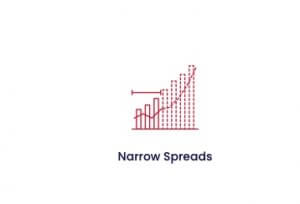
According to the Longhorn FX agents, spreads are their second selling points after the high leverage offer. The floating spreads on the website are updated on page reload, and they accurately represent what is on the MT4 platform. During our measurements, forex currency pairs spreads are low although not competitive with some larger brokers that offer 0 pips on majors. Starting with the biggest movers at the time of writing this article, GBP/JPY had two pip spread, CAD/JPY 1.3 pips, GBP/NZD 3 pips, EUR/NZD 3.5 pips. The lowest spread is for the USD/JPY pair at 0.7 pips while EUR/NZD had the highest. Exotic pairs spreads are nominally wider as expected. The widest is for USD/CZK with 2200 points, 1800 points for the USD/RUB, and around 1000 points for EUR/ZAR. Other exotic pairs have considerably lower spreads, below 600 points, the lowest is for USD/CNH at just six pips.
Indexes spreads are mostly above ten pips, and they behave like they are fixed. We have not noticed a change in value on any of them. The widest spread is contributed to AUS 200 with 410 and Nikkei 225 with 772 points, while the lowest is 77 points for the UK 100. SPX 500 has 99 points.
Oil spreads are modest; most of the time, it is below one pip for both types. Gold vs. USD has a great spread of 3 pips on average, the same as Gold vs. EUR. Silver has a somewhat lower spread than Gold at two pips.
Shares spread rarely go above 60 points, although the exceptions are Google with 200 points, illumine 115 points, and Amazon 127 points.
Crypto spreads are very good, and it clears out Longhorn FX is a crypto-specialized broker. BTC/USD has a $24 spread, 62 points for BCH/USD, DASH/USD has 34 points, 11 points for the Ethereum/USD, 71 points on EOS/USD, and the widest nominal spread is for the EDO/USD. We have not accounted for the BIT quoted spreads, as BIT is a derivative of Bitcoin.
Minimum Deposit
Longhorn FX promotes the leverage but does not mention a very low minimum deposit of $10. However, this minimum deposit is available only when you deposit with Bitcoin; each time we have tried with a fiat such as GBP, EUR, or USD, the minimum was 50. Since the deposit is made via a third party, Instacoins, any fiat conversion will be done through them. Bitcoin deposits go directly to the broker. Low minimum deposit and high leverage combination are good for managing the broker regulation risk while maintaining some buying power. This means account default is common, but at least you do not risk much in case the broker ceases operations or denies withdrawal.
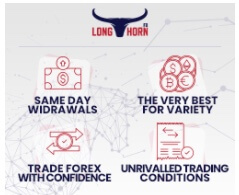
Deposit Methods & Costs
The only deposit method is via Bitcoin. Direct BTC deposits are made via address. You will be redirected to a special page with the BTC address and a timer of 15 minutes to deposit. After that time, the address will change. If you want to deposit via bank wire, MasterCard or VISA, you will need an account with Instacoins. Of course, you will again deposit with BTC once converted, so your refund protection provided by MasterCard or VISA is nulled. Some fees will apply when using Instacoins conversion, while direct BTC deposit via the BTC network has its usual fee of 0.0005 BTC, which is already added to the BTC amount to deposit. According to the broker, they will monitor your deposit transaction, and once six confirmations are made, the deposit will be confirmed and approved. Instacoins does not disclose fees unless you register. This company does not have a good reputation and does not have a strong regulation. According to some sources, the fee could be 10%, which is much higher than any major crypto exchange on the internet you can use instead to get BTC. According to sources by Longhorn FX, it is also mentioned you can use Coinbase to deposit BTC, but you can use any exchange.
Withdrawal Methods & Costs
Withdrawals are made to your BTC address you provide once you select the amount. The only option to withdraw is via Bitcoin. The broker does not apply any additional costs to withdrawals. You only need to pay the fixed Bitcoin network fee of 0.0005 BTC.
Withdrawal Processing & Wait Time
Since withdrawals are made by the Bitcoin network, the speed will depend on the network load. Most of the time, withdrawals are made in 6 hours timeframe, after six confirmations. Approval time by Longhorn FX should be done in one hour.
Bonuses & Promotions
Except for the Affiliate program, Longhorn FX does not have any bonuses, contests, or promotions. The affiliate program is seemingly well organized, giving solid commission rates of $3 out of referrals. Additionally, if your referral network grows, you may apply for a higher tier offering $4.5 commission per lot traded by the referral trader.
Educational & Trading Tools
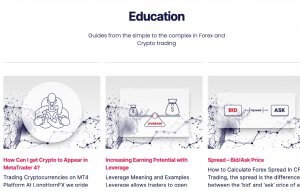
Longhorn FX has the Articles section, which could be regarded as educational. However, this section is not very deep. It contains eight articles, two out of which are guides on how to deposit by Card via Instacoins and Coinbase. Interestingly, Coinbase is not mentioned in the dashboard or as a deposit method except in this article. The other six articles cover basic trading subjects such as “Increasing Earning Potential with Leverage,” “Measuring Trades in Lots,” or “PIP – Percentage In Point.” None of them are serious enough for a complete education but are nicely written and presented with graphic examples.
Customer Service
Customer service has several contact channels. Issues can also be submitted via ticket service from the website client portal. Customer service is 24/7, and the agents are quick to respond on the chat app widget following you on every page. The chat is powered by LiveChat, also found with Instacoins. It has a nice feature to sent the chat transcript to your email. The agents are polite, responsive, and have enough knowledge, although limited in terms of company plans such as for the regulation. If you have technical questions, they will be able to assist you if the question is not covered in the FAQ, just do not expect deep answers that show impressive knowledge about trading. You will be able to contact Longhorn FX via email and social media messaging too. Social media pages are updated with news and promotional material but without anything more, like the analysis.
Demo Account
The demo account is not limited in any way, be it deposit amount or inactivity time. It reflects the commissions and all the trading costs. You will be able to open one easily, as explained above. There are several options to select; the leverage can be set up to 1:500 maximum, other. Lower levels are also available; funds amount can be set up to 5 million. Multiple demo accounts are possible to open, so you can test your EAs separately on each. Since Longhorn FX is pretty friendly when it comes to demo trading, we cannot say they push for deposits via limits or packages as some other offshore brokers.
Countries Accepted
 Another great benefit of offshore unregulated crypto-only brokers is the complete freedom who can sign up for trading. There is no need to verify your identity, proof of residence, or other documents. Only your phone and even that can be skipped if you do not want two-factor authentication protection. O course, you are responsible if your country prohibits crypto uses for trading, Longhorn FX will only present their risk disclosure.
Another great benefit of offshore unregulated crypto-only brokers is the complete freedom who can sign up for trading. There is no need to verify your identity, proof of residence, or other documents. Only your phone and even that can be skipped if you do not want two-factor authentication protection. O course, you are responsible if your country prohibits crypto uses for trading, Longhorn FX will only present their risk disclosure.
Conclusion
The primary concern about these broker types is their regulation and what happens to traders’ capital once they vanish from the internet. The only presence they have is online. You will not find them on the location provided on the website or the MT4 platform. Now, these brokers are a derivative of the crypto ideology of freedom. They will gain trust out of the published opinions of their clients on review websites, not a regulatory body. Cold storage of client accounts is a great security measure all crypto brokers use, but there is a higher risk you might lose your accounts without any way of recovery. Longhorn FX knows this, and that is why leverage and smaller accounts trading conditions are favorable. People will limit this risk by smaller accounts and boost trading with higher leverage, and as this investment platform gains reputation, so will the deposits.
If you have several EAs to plug in with smaller accounts, Longhorn FX might be a good pick. Unfortunately, we do not see why they are better than other crypto brokers out there. If you compare some small differences in the asset range and find an asset not available with others, then yes. However, this is probably a very small number of traders.
Longhorn FX is a new brand, and there are not many reviews or comments on them. On one popular review site, there are few comments or reviews without any negative ratings. Still, the number of reviews is not high enough to be accountable. It is not uncommon to see fake reviews if the benchmark websites do not have strong protection measures. One review we have found also mentioned the issue with the chart history, but that can be solved as explained above, but it may take some time. Overall, for now, you should use this broker as recommended, with small deposits or demo accounts until they gain a higher reputation.


